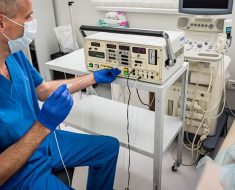(Reuters Health) – Clinicians who initially displayed race and gender bias in treatment of a hypothetical patient could be influenced to make recommendations that showed no bias after an intervention tested in a new study.
In the experiment, the researchers asked 840 clinicians to watch a video of either a white male or a Black female patient giving a clinical history detailing risk factors for heart disease and then give recommendations for treatment.
Initial results showed that the Black female patient was 150% more likely to receive unsafe recommendations compared to the white male patient, while the white male patient was 178% more likely to receive guideline recommended treatment than the Black female patient, according to the study published in Nature Communications.
When the experiment was rerun with the clinicians divided into two groups–a control with nothing changed and an experimental condition in which the clinicians were connected into a large, anonymous peer network of clinicians–the bias evaporated in the group networked with other doctors.
“Our findings show that medical reasoning can be viewed as a behavioral and social process, rather than as a purely individual, rational one,” said the study’s first author, Damon Centola, the Elihu Katz Professor of Communication, Sociology and Engineering at the University of Pennsylvania, and the author, most recently, of “Change: How to Make Big Things Happen.”
“Traditional hierarchies in medicine are broadcast systems for historical beliefs and biases, which flow to younger clinicians,” Centola said in an email. “While no single discovery or innovation can eradicate race and gender bias from medicine, a collective intelligence approach to medical reasoning may catalyze a badly-needed paradigm shift, in which we train future clinicians to seek answers through peer problem-solving networks rather than deferring to seniority.”
How would this work in the real world?
In many emerging fields like telemedicine and clinician support networks, existing digital infrastructures in hospitals and other care settings could easily be complemented with peer networking tools, Centola said. “Egalitarian peer networks could be incorporated into online group reasoning modules to support clinical decision making,” he said. “This approach represents a shift in thinking from the traditional logic of medical rationality, in which individual doctors make rational decisions, to a social logic of medical collective intelligence, which can help to build a more robust, effective, and equitable system of healthcare.”
In both parts of the study, participating physicians viewed actors playing patients who appeared to be 65 years old. The white male and the Black female were dressed in identical attire and depicted a patient with clinically significant chest pain. The actors followed a single script, in which they provided a clinical history that included several risk factors for coronary artery disease – age, high cholesterol, discomfort with exertion – and were accompanied by an electrocardiogram exhibit that showed abnormalities.
Clinicians chose between four possible treatments: A) daily 81mg aspirin and return to clinic in one week (the unsafe under-treatment option), B) daily 31 mg aspirin and stress test within two to three days (under-treatment), C) full-dose aspirin and referral to emergency department for evaluation and monitoring or D) full-dose aspirin and referral to cardiology for urgent cardiac catheterization (over-treatment for a patient who didn’t have a confirmed diagnosis). Option C represents standard of care.
In the second part of the experiment, clinicians were connected into a large, anonymous peer network with 40 other clinicians. Each participant was able to see the evaluations made by their network peers and had an opportunity to change their recommendations.
“The results of this study are tantalizing and potentially promising, and left me eager to learn more,” said Dr. Albert Wu, an internist and professor of health policy and management at the Johns Hopkins Bloomberg School of Public Health.
“For example, in the design that was used, the patient was either a white male, or a Black female,” Dr. Wu said in an email. “To me, their initial results suggest a race bias, a gender bias, or both, which was then reduced by their network-sharing intervention.”
“I would be curious to know if the results would be replicated for both Black and white males, and Black and white females,” Dr. Wu said.
While the researchers are optimistic about how these technologies may improve health care in the future, “for now, I’d be happy to conclude that this innovation is worth further investigation,” Dr. Wu said.
SOURCE: https://go.nature.com/3FiHET4 Nature Communications, online November 15, 2021.
Source: Read Full Article





